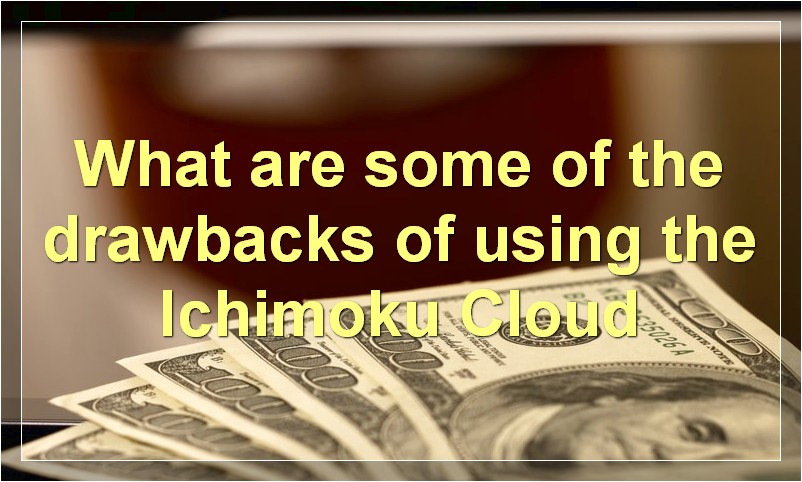If you’re looking to get started with Ichimoku, or want to learn more about this versatile tool, this guide is for you.
What is the Ichimoku Cloud

The Ichimoku Cloud is a technical indicator that can be used to gauge the momentum of a market. It is comprised of three lines: the Tenkan-sen, the Kijun-sen, and the Chikou Span. The indicator can be used on any timeframe, but is most commonly used on daily charts.
The Ichimoku Cloud is a powerful tool because it takes into account both price and time. The Tenkan-sen line is derived from the highest high and lowest low over the past nine periods, while the Kijun-sen line is derived from the highest high and lowest low over the past 26 periods. The Chikou Span line is simply the current closing price projected 26 periods into the future.
The interaction between these three lines can provide valuable insights into the momentum of a market. For example, if the Tenkan-sen line crosses above the Kijun-sen line, it indicates that the market is in an uptrend. Conversely, if the Tenkan-sen line crosses below the Kijun-sen line, it indicates that the market is in a downtrend.
The Ichimoku Cloud is a versatile indicator that can be used in a variety of ways. It is especially useful for identifying trend changes and spotting potential trading opportunities.
How is the Ichimoku Cloud used in trading
The Ichimoku Cloud is a technical indicator that is used to identify potential areas of support and resistance in financial markets. The indicator is composed of four main elements: the tenkan-sen, kijun-sen, senkou span A, and senkou span B. These elements are used to generate buy and sell signals, as well as to identify potential areas of support and resistance.
The tenkan-sen is the shortest of the three moving averages that make up the Ichimoku Cloud, and is used to generate buy and sell signals. A buy signal is generated when the tenkan-sen crosses above the kijun-sen, and a sell signal is generated when the tenkan-sen crosses below the kijun-sen.
The kijun-sen is a longer-term moving average that is used to identify potential areas of support and resistance. The senkou span A is a leading indicator that is used to identify potential areas of support and resistance. The senkou span B is a lagging indicator that is used to confirm trends.
The Ichimoku Cloud can be used in conjunction with other technical indicators to generate buy and sell signals. It can also be used to identify potential areas of support and resistance.
What are the benefits of using the Ichimoku Cloud
The Ichimoku Cloud is a popular technical indicator that can be used to identify potential support and resistance levels, as well as trend direction and momentum. The Ichimoku Cloud is comprised of five different lines, which are used to generate buy and sell signals. The Ichimoku Cloud can be used on any time frame, but is most commonly used on daily charts.
The Ichimoku Cloud can be a useful tool for identifying potential support and resistance levels. The cloud can also be used to identify the direction of the trend and momentum. The Ichimoku Cloud is comprised of five different lines, which are used to generate buy and sell signals. The Ichimoku Cloud can be used on any time frame, but is most commonly used on daily charts.
How does the Ichimoku Cloud help traders identify trends
The Ichimoku Cloud is a technical indicator that can help traders identify trends in the market. The indicator is composed of five different lines, which are used to generate buy and sell signals. The Ichimoku Cloud can be used on any time frame, but it is most commonly used on daily and weekly charts.
The Ichimoku Cloud consists of five different lines:
The Tenkan-Sen line is the blue line in the center of the cloud. This line is generated by taking the average of the highest high and the lowest low over the past nine periods. The Tenkan-Sen line is used to generate buy and sell signals.
The Kijun-Sen line is the red line in the cloud. This line is generated by taking the average of the highest high and the lowest low over the past 26 periods. The Kijun-Sen line is used to confirm trends.
The Chikou Span line is the green line that runs through the cloud. This line is generated by plotting the most recent closing price 26 periods behind the current price. The Chikou Span line is used to identify support and resistance levels.
The Senkou Span A line is the upper boundary of the cloud. This line is generated by taking the average of the Tenkan-Sen and Kijun-Sen lines and plotting them 26 periods ahead of the current price. The Senkou Span A line is used to identify potential areas of support and resistance.
The Senkou Span B line is the lower boundary of the cloud. This line is generated by taking the average of the highest high and lowest low over the past 52 periods and plotting it 26 periods ahead of the current price. The Senkou Span B line is used to identify potential areas of support and resistance.
What are some of the drawbacks of using the Ichimoku Cloud

One of the drawbacks of using the Ichimoku Cloud is that it can be difficult to interpret. The cloud can be used as a support or resistance level, but it can also be interpreted as a continuation pattern. This means that there is potential for false signals.
Another drawback is that the Ichimoku Cloud is a lagging indicator. This means that it will often times give you signals after the move has already started. This can lead to missed opportunities or even losses if you are not careful.
The final drawback of using the Ichimoku Cloud is that it is not well suited for volatile markets. This is because the cloud can often widen during periods of high volatility, which can lead to false signals.
How can traders use the Ichimoku Cloud to make better trading decisions
The Ichimoku Cloud is a powerful tool that traders can use to make better trading decisions. It is a technical indicator that can help traders identify potential support and resistance levels, as well as trend direction. The Ichimoku Cloud is comprised of four different lines: the tenkan-sen, the kijun-sen, the senkou span A, and the senkou span B. These lines are used to generate buy and sell signals, as well as to identify potential areas of support and resistance.
The tenkan-sen is the shortest of the four lines and is used to generate short-term buy and sell signals. The kijun-sen is a bit longer than the tenkan-sen and is used to generate medium-term buy and sell signals. The senkou span A is the longest of the four lines and is used to identify potential areas of support and resistance. The senkou span B is the second longest of the four lines and is used to confirm signals generated by the other three lines.
The Ichimoku Cloud can be a helpful tool for traders who are looking to take advantage of short-term or long-term trends. It can also be used to identify potential areas of support and resistance. However, it is important to remember that the Ichimoku Cloud is a technical indicator, which means that it should not be used as the sole basis for making trading decisions. Rather, it should be used in conjunction with other technical and fundamental analysis tools.
What are some common mistakes that traders make when using the Ichimoku Cloud
1. One of the most common mistakes that traders make when using the Ichimoku Cloud is failing to properly identify the key support and resistance levels. The Ichimoku Cloud can be a great tool for identifying these levels, but if you don’t know where to look, you can easily get caught up in the noise.
2. Another mistake that traders make is failing to take into account the time frame that they are trading on. The Ichimoku Cloud is a great tool for longer-term traders, but if you are looking for shorter-term signals, you may want to use another indicator.
3. Finally, many traders fail to properly use the stop-loss orders when trading with the Ichimoku Cloud. This can lead to some big losses if the market moves against you. Make sure you know where your stop-loss orders should be placed before entering any trade.
How can traders avoid making these mistakes
There is no surefire way to avoid making mistakes while trading, but there are certain things that traders can do to minimize the frequency and severity of their mistakes. One of the best ways to avoid making mistakes is to have a well-defined trading plan and to stick to it. A trading plan should include things like entry and exit criteria, position sizes, risk management rules, and so on. By having a plan and sticking to it, traders can avoid making impulsive decisions that are often the root of many trading mistakes.
Another way to avoid making mistakes is to keep a trading journal. In a journal, traders can track their trades, both wins and losses, and analyze what went right or wrong in each case. This helps them to identify patterns in their own behavior that might lead to mistakes, and then take steps to avoid those situations in the future.
Of course, even the best traders will make mistakes from time to time. The key is to learn from those mistakes and to use them as an opportunity to improve your trading skills.
What are some other resources that traders can use to learn more about the Ichimoku Cloud
In addition to books and online articles, there are a few other resources that traders can use to learn more about the Ichimoku Cloud. These include webinars, courses, and software programs.
Webinars are a great way to learn from experienced traders who use the Ichimoku Cloud in their own trading. There are many different webinars available on the internet, so traders can choose one that fits their schedule and learning style.
Courses are another excellent resource for learning about the Ichimoku Cloud. These can be found both online and offline. Many courses will provide traders with a comprehensive education on the Ichimoku Cloud, including its history, applications, and techniques.
Finally, there are several software programs that traders can use to help them learn about the Ichimoku Cloud. These programs can be used to create charts and backtesting data, as well as to trade directly from the program.

